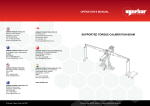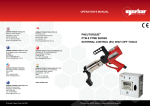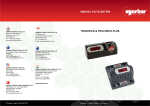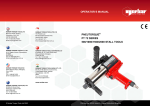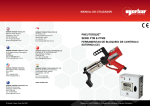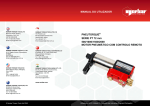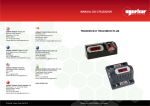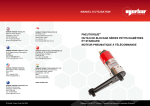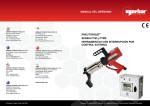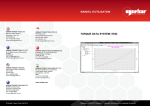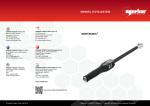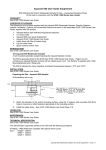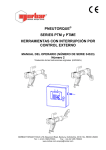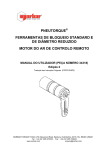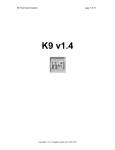Download Operators Handbook
Transcript
OPERATOR’S MANUAL NORBAR TORQUE TOOLS LTD Beaumont Road, Banbury, Oxfordshire, OX16 1XJ UNITED KINGDOM Tel + 44 (0)1295 270333 Email [email protected] NORBAR TORQUE TOOLS PTE LTD 194 Pandan Loop #07-20 Pantech Business Hub SINGAPORE 128383 Tel + 65 6841 1371 Email [email protected] NORBAR TORQUE TOOLS PTY LTD 45–47 Raglan Avenue, Edwardstown, SA 5039 AUSTRALIA Tel + 61 (0)8 8292 9777 Email [email protected] NORBAR TORQUE TOOLS (SHANGHAI) LTD E Building–5F, no. 1618 Yishan Road, Minhang District, Shanghai CHINA 201103 Tel + 86 21 6145 0368 Email [email protected] NORBAR TORQUE TOOLS INC 36400 Biltmore Place, Willoughby, Ohio, 44094 USA Tel + 1 866 667 2279 Email [email protected] NORBAR TORQUE TOOLS INDIA PVT. LTD Plot No A-168, Khairne Industrial Area, Thane Belapur Road, Mahape, Navi Mumbai – 400 709 INDIA Tel + 91 22 2778 8480 Email [email protected] TORQUE SCREWDRIVER TESTER (TST) SERIES 2 FOR USE WITH TST’S FITTED WITH VERSION 37712.301 SOFTWARE www.norbar.com NORBAR TORQUE TOOLS (NZ) LTD B3/269A Mt Smart Road Onehunga, Auckland 1061 NEW ZEALAND Tel + 64 9579 8653 Email [email protected] © Norbar Torque Tools Ltd 2013 Part Number 34294 | Issue 6 | Original Instructions (English) CONTENTS Introduction Part Numbers Covered by This Manual Parts Included Accessories 2 2 2 2 Features and Functions 3 Set Up Preparation Set Up for Use Flow Diagrams 4 4 5 7 Measure User Units Using the Key Pad Screen Layout Modes of Measurement Power Saving & Power Down Limits 10 11 11 12 14 15 16 External Transducer Interface Transducer Leads Available Specifications PIN Connections Connector Type 17 17 18 18 18 Ancillaries PIN Connections External Print / Reset Limit Outputs Analogue Output Connector Type 19 19 19 19 20 21 Serial Port Specifications Pulse Count Hyperterminal Limits PIN Connections Data Output Example Connector Type Connecting Lead 21 21 22 22 22 22 22 23 23 Maintenance TST Calibration Transducer Calibration Battery Replacement Repair Cleaning Disposal (Recycling Considerations) 23 23 23 23 24 24 24 Specifications 25 Trouble Shooting Error Messages Problems 26 26 26 Glossary of Terms 27 1 INTRODUCTION Torque Screwdriver Tester (TST) is a bench top measuring instrument with both an internal transducer and an external transducer input. It has 10 measurement modes, 13 units of torque (with additional USER units feature), 12 pairs of limits and text displayed in 11 languages. Part Numbers Covered By This Manual 43212 – Torque Screwdriver Tester (TST) 2 43213 – Torque Screwdriver Tester (TST) 10 43214 – Torque Screwdriver Tester (TST) 25 Parts Included Description Part Number TST 2 2 N∙m Capacity (43212) TST 10 10 N∙m Capacity (43213) TST 25 25 N∙m Capacity (43214) 50539 50540 50541 Joint simulator a.c. power adapter 38877 2 off M10 x 25mm long screw 25355.25 8 mm hex key 24938 ¼” hex to ¼” hex male adapter 28902 ¼” sq to ¼” hex socket 29193 ⅜” sq to ¼” hex socket 29194 x x Operators Manual 34294 2 off Calibration Certificates Quick reference card(s) 34292 Power cord NOTE: Serial data lead 39264 TST carry case 26717 The TST comes with one joint simulator but additional simulators can be ordered separately. Accessories 2 Description Part Number TST to 10 way lead, for Norbar Rotary Transducers 60216.200 TST to 6 way lead, for Norbar Static & Annular Transducers 60217.200 TST to no connector (for non-Norbar transducers) 60223.200 Serial Data Lead Kit 60248 Extensive range of torque transducers Contact Norbar FEATURES AND FUNCTIONS The pictorial panel allows easy mode selection for the 6 modes of operation. Additionally the 4 Peak modes can be configured for automatic reset. Conveniently situated integral transducer. External transducer connector. Automatically recognises any ‘SMART’ Norbar transducer. Can also work with most mV/V transducers from Norbar or other manufacturers. 13 Torque units, plus the ability to specify USER measurement units up to a maximum of 6 characters. 5 digit resolution for all Norbar transducers. Operational from internal rechargeable battery or a.c. supply. Fast battery charge in 3 hours 20 minutes. There are 12 pairs of limits available. Each limit has a target value and upper / lower tolerances. The display shows LO / OK / HI with bright LED’s to signal AMBER / GREEN / RED for easy confirmation. The limit status is also output on the ancillaries connector and serial port. A joint simulator for clockwise testing of power tools. Pulse count feature in Impulse Tool mode & Clutch Tool mode. User selectable frequency response for each mode of operation. Password protection of all selectable features. The instrument can be issued to an operator with only the required modes of operation and units of measurement enabled. This feature can virtually eliminate operator induced errors. Ancillaries connector with analogue output & GO/NO GO control for external equipment. Serial Port for data output to a PC or printer. Serial Port set up options include: sending time & date, limit status and continuous output. 3 SET UP Preparation NOTE: 1. If the equipment is used in a manner not specified by the manufacturer, the protection provided by the equipment may be impaired. Secure TST to a flat surface with the 2 bolts and hex key provided. 9 V d.c. input INT/EXT Transducer Selection Button NOTE: Transducer Connector Ancillaries Connector Serial Port Connector ON (I)/ OFF (O) switch The transducer selection button is labeled ‘INT’ for INTERNAL or ‘EXT’ for EXTERNAL. 2. If using an external transducer, plug cable into transducer connector. Select ‘EXT’ with Transducer Selection Button. 3. To output data to an external device (PC or printer) connect to the SERIAL PORT. 4. If using with a control or shut-off system, plug into ANCILLARIES connector. WARNING: 5. ALLOW THE TST TO EQUALISE TO THE AMBIENT TEMPERATURE/HUMIDITY BEFORE SWITCHING ON. WIPE OFF ANY MOISTURE BEFORE USE. The TST can be powered from mains or battery. It is essential to charge the internal battery for 200 minutes (3 hours & 20 minutes) before battery use. To charge the internal battery connect the a.c. power adapter between the TST (9 V d.c. input) and a live a.c. supply. TIP: Insert 9 V d.c. connector into TST before applying a.c. mains to ensure correct charging. TIP: If the power cord has no plug fitted, wire as follows: BROWN-LIVE BLUE-NEUTRAL GREEN / YELLOW-EARTH If in doubt consult a qualified electrician. TIP: 4 The display backlight is ON when connected to a.c. power. The TST can be used whilst the battery is charging. Recharging is independent of the on/off switch. The battery can be charged continuously. Set Up For Use Turn TST on and wait for LOGO. The TST will either enter the measure screen or display ‘CONNECT TRANSDUCER’. Press to obtain SET UP menu: 17. SET UP SOFTWARE # 37712.XXX X 1. LIMITS 2. SETTINGS 3. RETURN TO MEASURE TO CONFIRM NOTE: The set up is password protected, the default password is 000000. TIP: If password is lost, contact Norbar quoting the coded number in brackets on the password menu. TIP: When in a set up screen, after entering one option press the down arrow to enter the next. When all entry’s have been made, press ‘’. 1. Limits The user can set up to 12 target values that each have two settable LIMITS. To set the limits the following are needed: Parameter Comment Target Number Select 1 to 12. Units for limits Target value Select torque units (or specify USER units). Torque value required. Upper limit The % allowed above target. Lower limit Operate The % allowed below target. OFF or Clockwise or Anticlockwise or Both directions. Confirm limits Limit values shown in % of the target value. Select next target to set up. Press when finished. For more information see flow diagram on page 7. 5 2. Settings Setting LANGUAGE PASSWORD Options (defaults) ENGLISH (default), FRANCAIS, DEUTSCH, ITALIANO, ESPAÑOL, DANSK, NEDERLANDS, SUOMI, NORSK, SVENSKA, PORTUGUES. Any 6 numeric characters (default = ‘000000’). Comment Set language of operation. Set Password. DATE & TIME Set date DD/MM/YY or MM/DD/YY. MODE FREQUENCY 100Hz to 2500Hz (defaults, see ‘MODES Select mode then select frequency from list. OF MEASUREMENT’ section). OTHER FREQUENCY allows a custom value. SERIAL PORT See ‘SERIAL PORT’ section. THRESHOLDS FIRST PEAK SENSITIVITY = LOW / MEDIUM / HIGH (default = HIGH). THRESHOLDS AUTO RESET HOLD TIME = 1 (default) / 2 / 3 / 4 seconds. THRESHOLDS TRIGGER FROM = 0.5% to 99% of transducer capacity (default = 1.8 %). THRESHOLDS PEAK MEMORY RESET = AUTO / MANUAL (default). This is the amount by which the torque must drop to register a first peak. LOW must drop 10% of reading. MEDIUM must drop 5% of reading. HIGH must drop 2.5% of reading. The time allowed for automatic reset in ‘Click & Cam’ mode. This is the point at which any memory mode starts to work, all memory modes will ‘TRACK’ below this setting. This can help overcome false results. Values entered below 0.5% will act as 0.5%. All Peak modes will reset the highest reading automatically or manually. UNITS All units (default = all enabled). Turn off unwanted torque units. MODES All modes (default = all enabled). Turn off unwanted modes. POWER DOWN TIME 0 to 99 minutes (default = 10). PRINT SETTINGS None. TIP: 24 hour clock with date. Select required options. The time before power down starts. Set to ‘0’ to disable. All settings and limit settings can be printed. No password is needed. When or is shown on screen, this means more menu items are available. For more information see flow diagram on page 9. 3. Return to Measure This option allows the user to view the measurement screen. For ‘SMART’ transducers the measure screen is automatically entered. For ‘NON-SMART’ transducers the option to store transducer details is available. For more information see flow diagram on pages 7 & 8. 6 Flow Diagrams All set up menus are numbered on the TST for ease of identification. Menu Structure + Limits Flow Diagram SWITCH ON DISPLAY TRANSDUCER DETAILS DISPLAY LOGO # TRANSDUCER DETAILS SCREEN MEASURE RETURN TO MEASURE SMART TRANSDUCER ? YES EXIT NO 17. SET UP SOFTWARE # XXXXX.XXX 1.LIMITS 2.SETTINGS 3.RETURN TO MEASURE SETTINGS A B 22. CONFIRM LIMITS LIMITS 91. SELECT TARGET PASSWORD 19. SELECT UNITS 20. SET TRANSDUCER LIMITS EXIT Password Flow Diagram Password flow diagram 27. ENTER PASSWORD CORRECT PASSWORD PROCEED CORRECT PASSWORD PROCEED INCORRECT PASSWORD 28. RE-ENTER PASSWORD INCORRECT PASSWORD ACCESS DENIED 7 8 MENU 17 A EXIT MEASURE TRANSDUCER DETAILS SCREEN 16. SHOW TRANSDUCER 15. SELECT TRANSDUCER 8. SAVE WHERE ? YES 7. SAVE TRANSDUCER ? 14. CALIBRATION FIGURE 13. TRANSDUCER PARAMETERS ADD 5. TRANSDUCER ADD TRANSDUCER EDIT/PRINT/DELETE USE SERIAL # : XXXXX USED SAVED TRANSDUCER NO USE SERIAL# 12345 USE SAVED 2. CONNECT TRANSDUCER 14. TRANSDUCER CALIBRATION FIGURE 13. TRANSDUCER PARAMETERS 9. SELECT TRANSDUCER EDIT/PRINT/DELETE EXIT MENU 17 PRINT PRINTING TRANSDUCERS EDIT YES 11. DELETE TRANSDUCER ? 10. SELECT TRANSDUCER DELETE NO DELETE ALL 6. EDIT/PRINT/DELETE TRANSDUCERS EDIT PRINT DELETE DELETE ALL Measure flow diagram YES 12. DELETE ALL TRANSDUCERS ? NO Measure Flow Diagram Settings Flow Diagram 29. SET LANGUAGE PASSWORD LANGUAGE 31. ENTER NEW PASSWORD PASSWORD 32. NEW PASSWORD IS PASSWORD B 33. SET DATE PASSWORD TIME & DATE 26. SET UP/SETTINGS LANGUAGE PASSWORD DATE & TIME MODE FREQUENCY SERIAL PORT THRESHOLDS UNITS MODE ENABLE/DISABLE POWER DOWN TIME PRINT SETTINGS 87. SELECT MODE PASSWORD MODE FREQUENCY SERIAL PORT 35. SET TIME 39. SET SERIAL PORT PASSWORD THRESHOLDS PASSWORD UNITS 43. SET TORQUE UNITS PASSWORD MODE ENABLE/ DISABLED PRINT PASSWORD 86. TEST OUTPUT 41. SET THRESHOLDS FIRST PEAK SENSITIVITY/ AUTO RESET HOLD TIME/ TRIGGER FROM/ PEAK MEMORY RESET EXIT MENU 17 37. SET FREQUENCY 46. SET UP MODES POWER DOWN PASSWORD 48. SET POWER DOWN TIME PRINT 9 MEASURE 1. Set up the TST as described in the previous section. 2. Turn TST on. 3. For ‘SMART’ transducers the TST automatically shows the transducer input selected (TD#INT or TD#EXT), the transducers capacity and units. The transducer’s serial number and direction of linearization (if enabled) are also shown. The instrument then displays the measurement screen. TD#XXX CAPACITY XXXXX N∙m TRANSDUCER SERIAL # XXXXX LINEARISED X NOTE: 4. If the word ‘LINEARISED’ and direction arrows appear on this screen then the TST is using a second order polynomial to linearise the transducer. If ‘Menu 2’ is shown, then either: a) A ‘SMART’ transducer is not connected. b) The transducer is ‘NON-SMART’. For ‘NON-SMART’ transducers the transducer details can be saved in the TST for future use. Transducer details can be edited, deleted or printed. The last transducer used will always be retained for quick selection. Follow ‘measure flow diagram’ in SET UP section & refer to TRANSDUCER INTERFACE section. TIP: For entry of transducer data, see the ‘USER UNITS’ and ‘USING THE KEY PAD’ sections on page 11. c) The ‘Transducer Selection switch’ is in the wrong position. 5. The TRACK screen is now displayed. Exercise the transducer in required direction of use. 6. Press ‘ZERO’ to zero displayed reading. TIP: 7. TIP: 8. 10 The measurement display may not zero if outside +/-3% of transducer capacity. This may be due to transducer overstrain. Return defective transducer to Norbar. Select measurement mode required. If any measurement mode does not memorise the measurement value, ensure that the ‘TRIGGER FROM’ setting is correct. See SETTING, SETUP/THESHOLDS menu. TRIGGER FROM can be used to overcome erratic results being obtained. Press to exit any measurement screen and go to SET UP. User Units This feature allows the USER to specify custom measurement units that are displayed after the measurement value and printed on the serial port. Any mV/V transducer conforming to the specifications in the TRANSDUCER INTERFACE section can be used. Typical examples could be load or pressure transducers. 1. When ‘2. MEASURE’ is displayed, press ‘ TO CONFIRM’. 2. Select ’13. ADD TRANSDUCER’ and press ‘ TO CONFIRM’. 3. Enter ‘SERIAL #:’ and press ‘’. Enter ‘PART NUMBER: (if required) and press ‘’. 4. The user can choose the ‘UNITS OF CALIBRATION:’. Press whilst the display is showing ‘N∙m’, 6 underscores will be displayed (______). Now input the required ‘UNITS OF CALIBRATION’, for example ‘kN’. Press ‘’ when input has finished. 5. Enter ‘RATED CAPACITY:’, press ‘ TO CONFIRM’. N∙m, dN∙m, lbf∙ft ……. TIP: The TIP: Only limits set up in the same USER units are available for selection when in measure. 7 button will have no effect when in measure. Using the Key Pad Press and hold the required key until the desired character is displayed, then release. Key 1 1, a, A, b, B, c, C Character NOTE: 2 2, d, D, e, E, f, F 3 3, g, G, h, H, i, I 4 4, j, J, k, K, l, L 5 5, m, M, n, N, o, O 6 6, p, P, q, Q, r, R 7 7, s, S, t, T, u, U 8 8, v, V, w, W 9 9, x, X, y, Y, z, Z 0 0 The keys 0 – 9 are shortcuts for menu selection. Key Function # Entry of: #%()*,/:=\_ . Entry of: . (full stop or decimal point) + - a) b) c) d) e) Navigate menu options and choices. Left arrow becomes delete when entering data. Right arrow becomes space when entering data. Down arrow moves on to next option in a set up menu. Use left and right arrows for quick selection of torque units in measurement screen. Confirm change. NOTE: If the change is not confirmed, it will not be made. 11 Screen Layout A J C B TARGET 1=100 N∙m PRINT I 12.34 HI H IMPULSE TOOL (500 Hz) G Display A. F STOP D N∙m _∏_#=0 E Instruction Press to select target value and associated limits to be used. Time/Date shown if no targets set. B. Measurement reading. C. Press D. Indicates when to stop loading in to exit. Pulse count when in 4 E. 3 or CLICK & CAM measurement mode. 5 measurement modes. In ‘IMPULSE TOOL’ & ‘CLUTCH TOOL’ modes, a count is added every time the torque passes above & below the ‘trigger from’ setting. F. Units of measurement G. Current ‘mode of measurement’ in use along with frequency response set for that mode. H. Limit indication (if enabled). I. Direction of measurement. J. 12 Press 9 to toggle between ‘ PRINT’ and ‘X PRINT’ on the display. PRINT enables serial port, X PRINT disables serial port. Key Function N∙m, dN∙m, lbf∙ft ……. 7 8 PRINT reading and RESET. To view transducer details in track mode. Shows: Serial #, Part Number, Units & Rated Capacity. Clockwise & anticlockwise mV/V Calibration figures. Angle option programmed (for use with Pro-Log instrument) Clockwise & anticlockwise linearised values, where T=a + bR + cR² (T is torque & R is Ratio in mV/V). # ZERO Selection of enabled torque units. 0 TRACK mode: - Zero transducer (It is recommended to check the zero when returning from power down). All other modes: - PRINT reading and RESET. For selection of torque units. PRINT reading and RESET. TIP: To simplify operation disable all units of measurement not required. See SETTINGS, UNITS ENABLE/DISABLE menu. 13 Modes of Measurement Mode 1 Mode (Frequency) How it Works TRACK (500 Hz) Follows signal. Visual Representation Dial & Electronic (500 Hz) 4 Impulse Tool (500 Hz) 5 Clutch Tool (500 Hz) 6 3 Holds the highest reading until RESET by the user. [The highest reading can be automatically reset if AUTO is selected for PEAK MEMORY RESET. After the value returns to zero, the memorised reading is held for the AUTO RESET HOLD TIME, then resets]. Stall Tool (500 Hz) Click & Cam (500 Hz) st Hold 1 peak for the ‘AUTO RESET HOLD TIME’, then resets. AUTO RESET HOLD TIME TIP: To simplify operation DISABLE all modes of measurement that are not required. See SETTINGS, MODES ENABLE/DISABLE menu. TIP: The peak reading can be set up to automatically reset by changing PEAK MEMORY RESET from MANUAL to AUTO. See SETTINGS, THRESHOLDS TIP: For slower operation of any AUTO RESET mode, change AUTO RESET HOLD TIME to 4 SECOND. See SETTINGS, THRESHOLDS menu. TIP: In CLICK & CAM mode the serial port will only output for a genuine first peak. Pressing enter or ZERO will not send an output. TIP: If torque wrench readings are inconsistent in CLICK & CAM mode, change FIRST PEAK SENSITIVITY in the SETTINGS, THRESHOLDS menu to be less sensitive i.e. MEDIUM or LOW. This will compensate for torque wrench sensitivity. 14 Power Saving & Power Down Battery life can be greatly increased from a minimum of 14 hours by making use of power down. If no key is pressed or measurement reading taken in the specified time, the TST will enter power down. The following will be displayed: SAVING POWER PRESS ANY KEY TO CONTINUE The following features should be noted: The POWER DOWN TIME is set in the SETTINGS, POWER DOWN TIME. For maximum battery life set POWER DOWN TIME to 1 minute. To disable the power down feature set POWER DOWN TIME to 0 (zero). The TST also enters power down when in a set up menu. The analogue output will NOT work during power down. TIP: Check the zero setting of the transducer on return from power down. When the battery is low there is approximately 20 minutes of use left. In the measure screen a flashing battery symbol will be seen in the top right hand corner of the display. In a SET UP menu, the following is displayed: WARNING #202 BATTERY LOW PRESS X When battery is flat the TST must be turned off or recharged. The following is displayed: WARNING #201 BATTERY FLAT SWITCH OFF AND RECHARGE BATTERY NOTE: From a very flat battery it may take 1 minute of mains power before the display will turn on. 15 Limits Limits can be selected In Measure by pressing or . The target is shown at the top left of the screen and if no limits have been set, the TIME & DATE will be shown. If limits are available but not selected, ‘↓↑LIMITS OFF’ will be shown. The limit status is shown in 4 ways: 1. On the display showing LO / OK / HI next to the torque value (updated at 3 Hz). 2. On AMBER / GREEN / RED LED’s on front panel (updated at 208 Hz). 3. On the Serial Port LO / OK / HI is sent before torque value (updated with serial port). 4. On the Ancillaries LO / OK / HI logic outputs (updated at 208 Hz). TIP: The Ancillaries are updated quickly to give a fast response to an external control system. NOTE: This difference in update rate may lead to very small differences between the changeover points. The LED’s & logic outputs change precisely with increasing torque, and at 0.5% of transducer capacity below the limit with decreasing torque. This eliminates the logic lines oscillating. The status of the limits changes as follows: Torque signal Display LED’s Serial port Ancillaries Zero band. (<0.5% of transducer capacity). OFF OFF No output No output. Under lower limit. LO AMBER LO LO output. Within limits. OK GREEN OK OK output. Above upper limit. HI RED HI HI output. NOTE: For operation of limits in one direction only, the opposite direction will be shown as LO. The limit operation is dependent on the measurement mode: Measurement mode Track Dial & Electronic Impulse tool Clutch tool Stall tool Click & Cam Limit operation Limits follow the transducer input and are not held. For PEAK MEMORY RESET = MANUAL, Limits status is held until PRINT / RESET is pressed. For PEAK MEMORY RESET = AUTO, Limit status is held until after the auto reset timer has operated. Limit status is held until after the auto reset timer has operated. TIP: When TST is switched on, the target shown is the last one used. TIP: The TST will automatically change torque units to those set by the limits. TIP: Limits can be set up in USER units for operation with transducers programmed with the same USER units. 16 EXTERNAL TRANSDUCER INTERFACE The external transducer interface has been designed for use with most four wire bridge strain gauge type transducers. When used with Norbar ‘SMART’ transducers the calibration data will be automatically known. For ‘NON-SMART’ transducers up to 20 sets of transducer parameters can be stored in the TST for ease of use. These can be configured with USER units. TIP: Mark ‘NON-SMART’ transducers with their stored ‘T’ number for ease of identification. For external transducers ensure the INT/EXT button on the right hand side of the TST is in the EXT position (button in). TIP: Press '#' in track mode to show details of transducer in use. TIP: If any of the transducer’s parameters are changed (i.e. re-calibration of mV/V value), the transducer’s stored parameters must be edited prior to use. (‘NON-SMART’ only). Norbar transducers with the following suffix are all suitable for use with the TST: Suffix Description XXXXX.IND ‘SMART’ transducer calibrated in mV/V. XXXXX.INDA ‘SMART’ transducer with integral angle encoder calibrated in mV/V. XXXXX.LOG ‘SMART’ transducer calibrated with a TST in units of calibration. A mV/V figure is also supplied. XXXXX.LOGA ‘SMART’ transducer with integral angle encoder calibrated with a TST in units of calibration. A mV/V figure is also supplied. NOTE: Transducers supplied for use with the Pro-Log are compatible with the TST. The TST will not display angle when interfaced to a .INDA or .LOGA transducer. ETS Transducers supplied with an amplifier module will need to be modified for use with the TST. Transducer Leads Available NOTE: Part Number Description 60216.200 TST to 10 way lead, for Norbar Rotary Transducers. 60217.200 TST to 6 way lead, for Norbar Static & Annular Transducers. 60223.200 TST to no connector (for non-Norbar transducers). The suffix after the part number indicates the length of the lead in cm, thus XXXXX.200 = 2 metres. If Transducer leads are required of a non-standard length, the new suffix must be added to the part number when ordering (to the nearest metre). 17 Specifications Parameter Minimum Maximum Bridge Resistance (). Millivolt / volt value (mV/V). 350 0.95 mV/V. +/- 3% of transducer capacity (3 mV/V). 4.5 Active digits. 1000 3.15 mV/V. +/- 9% of transducer capacity (1 mV/V). 5 Active digits. 0.010000 Dependent on transducer capacity and mV/V value. None. 1,500,000 N∙m, dN∙m, cN∙m, lbf∙ft, lbf∙in, ozf∙in, ft∙lb, in∙lb, in∙oz, kgf∙m, kgf∙cm, gf∙m, gf∙cm. 6 Characters. Zero balance. Display Resolution. Transducer capacity ranges. Torque units. User units. Displayable overrange. 120% of transducer capacity. Pin Connections Pin No Function 1 +ve transducer excitation. 2 3 -ve transducer excitation. +ve transducer signal. 4 -ve transducer signal. 5 6 Digital 0 volts. Digital +5 volts for transducer selected, digital 0 volts when not selected. 7 8 Rotary transducer angle input (Channel A). Rotary transducer angle input (Channel B). 9 Serial clock (SMART memory). 10 Serial data (SMART memory). Connector Type ® Lemo 10 way panel socket, size 2B. The mating part to this connector is a Lemo 10 way, size 2B free plug, manufacturers part number FGG.2B.310.CLAD722. TIP: 18 If the display shows ‘SMART TD NOT INITALISED’ it is likely that: a) Unmodified ETS transducer connected. b) The transducer lead may have a broken connection. c) ‘SMART’ transducer may have lost its stored data, return to Norbar. ANCILLARIES The ancillaries connector contains GO / NO GO control limits for external equipment, an analogue signal output and a PRINT / RESET signal input. Pin Connections Pin No TIP: Function 1 Digital +5 volts (maximum current 5 mA). 2 3 External PRINT / RESET input (Active High). Low limit output (LO). 4 Pass limit output (OK). 5 6 High limit output (HI). Not Used. 7 8 Not Used. Auto reset display hold input (Active high). 9 10 Digital 0 volts. First Peak Detect output (High when first peak active). 11 Analogue Output. 12 13 Analogue Output 2.5V. Analogue Output 0V reference (Do not connect to a noisy electrical ground). 14 15 Rotary transducer angle output (Channel A). Rotary transducer angle output (Channel B). The angle output is available for a Norbar Rotary Transducer. For use see Rotary Transducer manual. External Print / Reset Pins 1 & 2 are intended for use as an EXTERNAL PRINT / RESET:PIN 1 PIN 2 Momentary Switch The switch must remain active for at least 200 mS. Screened cable is recommended. Limit Outputs Pins 3, 4 & 5 are buffered logic outputs intended for Go/No Go control of external equipment. All limit outputs are referenced to Pin 9 (Digital 0V). All limit outputs are active HIGH & change at 208 times per second. For more information on limits, see ‘LIMITS’ menu which can be accessed via the ‘SET UP’ menu. Limit output current, High = -0.8 mA, Low = 16 mA (not for direct control of relays). 19 Analogue Output The analogue output is designed for connection to a control system. It is a true analogue value, so has a very fast frequency response of above 10 kHz. The calibration of the analogue output is factory set and not adjustable, it is not affected by the instrument calibration. 5V Analogue Output Pin 11 2.5V Pin 12 Pin 13 The analogue output is PIN 11. If the output is measured against PIN 12 (2.5V) the signal will swing positive for clockwise torque and negative for anticlockwise torque. If the output is measured against PIN 13 (0V) the signal will always be positive, with zero torque around 2.5V. TIP: Some transducers (Norbar Annular type) will give a negative output change for a positive torque. This is because they are designed to measure reaction torque. The output voltage is a function of the mV/V value. The larger the mV/V value the larger the analogue output voltage. At transducer full scale the analogue output voltage (in volts) is numerically equal to the mV/V value divided by 2. TIP: Find the mV/V value by pressing ‘#’ in the track mode or refer to the transducer’s calibration certificate. Using 2.5V (PIN12) as a reference: Torque Analogue output (PIN 11) @ 1.0mV/V @ 2.0 mV/V @ 3.0 mV/V - full scale of transducer. -0.5 V -1.0 V -1.5 V Zero. + full scale of transducer. 0.0 V +0.5 V 0.0 V +1.0 V 0.0 V +1.5 V Using 0V (PIN13) as a reference: Torque @ 1.0mV/V Analogue output (PIN 11) @ 2.0 mV/V @ 3.0 mV/V - Full scale of transducer. Zero. 2.0 V 2.5 V 1.5 V 2.5 V 1.0 V 2.5 V + Full scale of transducer. 3.0 V 3.5 V 4.0 V TIP: The analogue output will not operate in power down mode. If using the analogue output continuously then disable the power down feature by setting to 0 (zero). The accuracy of the analogue output is +/- 2% of voltage reading. For a more accurate output value the voltage can be externally scaled against the displayed torque. 20 Connector Type 15 way female ‘D’ type connector. SERIAL PORT The serial port is for sending data to a PC or serial printer. When the TST is measuring, data can be output on the serial interface automatically when the AUTO RESET timer operates or when the 'PRINT / RESET' key is pressed. The data can include the measured value, units of measurement and time/date. Output can also be requested externally via pin 2 (ancillaries connector), see ancillaries section. Specifications Parity ODD, EVEN or OFF. Factory Defaults OFF Baud rate 1200, 2400, 4800, 9600 or 19200. 9600 The data rate. Data - Stop bits First character 8 – 2, 8 – 1, 7 – 2, 7 - 1. - or +/- or NONE. 8-2 - If required by receiver. Output Limits Output units YES or NO. YES or NO. YES YES Limit status sent before data. Measurement units sent after data. Output date & time YES or NO. NO Date & Time sent after data. Output line feed Handshake YES or NO. NONE, CTS or X-ON/OFF. NO NONE Line feed sent after data. If required by receiver. Line delay 0.00 to 9999 SECONDS. 0.50 Seconds Continuous output YES or NO. NO Time delay in data output. Up to 22 readings per second in track mode. Parameter Options Comments SET TO FACTORY DEFAULTS. Maximum number of characters per line = 24. Maximum number of requests in track mode = 4 per second (line delay set to 0). Transmitted data voltage levels are between +5 to +9 volts and –5 to -9 volts. Configured as DTE (Data Terminal Equipment) and conforms to RS-232-C specifications. TIP: If the serial port is not communicating with other equipment try: a) Check that all serial port parameters on the TST and the equipment receiving data match. b) Check that the baud rate is set to the same as the equipment receiving data. c) Check that the connecting lead is wired correctly at both ends. d) Check if equipment receiving data requires the units of measurement inhibited or a leading character. e) Select CONFIRM at the end of the serial port settings, the TST will keep sending a ‘TEST OUTPUT’ message to help fault finding. TIP: If the serial output is being overwritten set ‘Output Line Feed’ to YES. TIP: If the Serial data is being sent too quickly the printer may not keep up, so data is lost. To slow down the TST output change the ‘Line delay’ function. 21 Pulse Count When in IMPULSE TOOL or CLUTCH TOOL modes, the pulse count is output on the next line following the measured value. The pulse count will be output as follows ‘_/\_#=XXXX’. XXXX represents the number of pulses. Hyperterminal ® The standard HyperTerminal program found in Microsoft Windows allows the user to view and store serial output data. For more information see our web site www.norbar.com and select FAQ. TIP: Downloading of data can be speeded up by changing the LINE DELAY to 0 SECONDS. TIP: To regulate the CONTINUOUS OUTPUT, set LINE DELAY to required time period. Limits The serial port will output LO / OK / HI when the limits are being used. Some software, including the Norbar ‘Torque Wrench Calibration Software’ (Part 37705.XXX), will not accept LO / OK / HI characters. To remove LO / OK / HI, set OUTPUT LIMITS to ‘NO‘. The following table gives all options for the FIRST CHARACTER & OUTPUT LIMITS settings: First Character Direction +/NONE Clockwise Anti Clockwise Example with No Limits or OUTPUT LIMITS = NO 1.0335 N∙m -1.0335 N∙m Example with OUTPUT LIMITS = YES LO 1.0335 N∙m LO -1.0335 N∙m Clockwise Anti Clockwise +1.0335 N∙m -1.0335 N∙m LO +1.0335 N∙m LO -1.0335 N∙m Clockwise 1.0335 N∙m LO 1.0335 N∙m Anti Clockwise 1.0335 N∙m LO 1.0335 N∙m Pin Connections Pin No 1 2 3 4 5 6 7 8 9 Function Not Connected. Received data (to TST). Transmitted data (from TST). Not Connected. Signal ground 0V. Not Connected. Not Connected. CTS (clear to send). Not Connected. Data Output Example Code: DP = Decimal Point. CR = Carriage Return. SP = Space. TST with the serial port set to the factory defaults. Reading 1068.4 lbf∙ft (clockwise). 1 22 0 6 8 DP 4 SP l b f DP f t CR Connector Type 9 way male ‘D’ type connector. Connecting Lead A 9 way female to 9 way female null modem connecting lead is included with the TST for connection to a PC with a 9 way male connector. TIP: If PC to be used has a 25 way ‘D’ connector, use the Serial Data Lead Kit (part no 60248). MAINTENANCE TST Calibration Your TST has been supplied with a certificate of calibration. To maintain the specified accuracy it is recommended that the TST is recalibrated at least once per year. Re-calibration should be carried out at Norbar or by a Norbar approved agent to ensure the instrument is functioning at maximum accuracy. IMPORTANT: DO NOT REMOVE FRONT PANEL OR CASE; THERE ARE NO CALIBRATION SETTINGS INSIDE. Transducer Calibration To maintain the specified accuracy it is recommended that transducers are recalibrated at least once per year. Re-calibration should be carried out at Norbar or by a Norbar approved agent. Battery Replacement There are 2 batteries in the TST. Description Use Reason for Replacement Time & Date Time & Date fail CR2032 39202 Powers TST TST has short battery life 38876 38876 Battery Markings Part Number Coin cell 3V Battery pack 6V NiMH 23 To replace battery(s): 1. Turn TST off. 2. Remove 4 front screws with 2.5mm HEX key. 3. Lift the top of the panel to show PCB. 4. Replace coin cell (marked BATT1 on PCB) and / or replace battery pack (marked CONN4 on PCB). 5. Fit panel without trapping any internal wires and refit 4 front screws. CONN4 connection for battery pack, the red wire should be closest to the edge of the PCB BATT1 FIGURE 2 – TST PCB (inside TST) Repair Repair should be carried out at Norbar or by a Norbar approved agent, where all the facilities to ensure the instrument is functioning at maximum accuracy are available. NOTE: Only remove front panel for battery replacement; there are no other parts for user repair inside. Cleaning Do not use abrasives or solvent based cleaners. Disposal (Recycling Considerations) Component TST case. TST instrument base. Transducer Shaft. TST transducer base plate. Coin cell / Battery pack. Material Polyurethane. Aluminium. Aluminium (TST2) / Stainless steel (TST 10 & TST 25). Aluminium. Dispose of used battery in a safe way. Do not incinerate, mutilate or short circuit. For up to date disposal information, see our web site www.norbar.com. 24 SPECIFICATIONS Input voltage Equivalent torque Accuracy Calibration uncertainty* @0.5 mV @1.0 mV 5% of full scale. 10% of full scale. ±0.1% of reading. ±0.05% of reading. ±0.13% ±0.08% @2.0 to 18.9 mV 20% to 120% full scale. ±0.05% of reading. ±0.06% *Using a coverage factor of k=2, to give a confidence level of approximately 95%. Resolution: 5 digits for all Norbar transducers. Display: 240 x 64 pixel dot matrix display. With update rate of twice per second (2Hz). Torque Unit Conversions: To ‘BS 350:2004 Conversion factors for units’. Zero Suppression: TRACK None. ALL OTHER MODES Suppressed from 0 to approximately 0.5% of transducer calibration range. Password: 000000 (default), must be 6 characters. Time/Date: HH:MM:SS 24 Hour clock. DD/MM/YY or MM/DD/YY date format. Time/Date Compliance: To year 2062. Units of Measurement: See EXTERNAL TRANSDUCER INTERFACE section. First Peak Sensitivity: 2.5%(High), 5%(Medium), or 10%(Low) of reading. Auto Reset Hold Time: 1, 2, 3 or 4 seconds. Frequency Response: 8 Order Butterworth low pass filter with a –3dB point settable from 100 to 2500 Hz. Trigger from Setting: 0 to 99% of transducer capacity. Operating Temperature Range: +5°C to +40°C. Storage Temperature Range: -20°C to +70°C. Maximum Operating Humidity: 85% Relative Humidity @30°C. a.c. Power Adapter: 90 to 264 Volts a.c. at 50-60 Hz input. 9V, 300 mA d.c. output (centre positive). Power Down Time: 1 to 99 minutes (enter 0 to disable). Power Consumption: 2.4 W - maximum. Power Cable: 2 metres (6 ft 6 ins) long minimum. Power Plug Fuse (if fitted): 1 Amp. Battery Pack: 1600 mAh, 6.0 volt (5 cell) NiMH (Recharge time 200 minutes). Coin Cell: Renata 190 mAh (CR2032FH). Weight: 2.2 kg (4.8 lb). Dimensions: 160 mm deep x 288 mm wide x 72 mm high. Case Materials / Finish: Rigid polyurethane with fine texture acrylic paint finish. Stainless steel transducer shaft and Aluminium base plate. Environment: Indoor use within a light industrial environment. Electromagnetic Compatibility: In conformance with EN 61326 : 1997. th (EMC) Directive Low Voltage Directive: NOTE: In conformance with EN 61010-1 : 2001. To environmental conditions Pollution Degree 2 & Installation Category (Over voltage Category) II. Due to continuous improvement all specifications are subject to change without prior notice. 25 TROUBLE SHOOTING Tips are located within the manual to help with troubleshooting. Error Messages Error messages are displayed to help the user, with audible warnings given when necessary. Common error messages are: Error # Message Comment 312 313 TRANSDUCER CAPACITY > 1,500,000 TRANSDUCER CAPACITY < 0.01 Wrong value entered. Wrong value entered. 314 CALIBRATION FIGURE NOT 0.95 TO 3.15 MV/V Wrong value entered. 316 317 NO TRANSDUCER TO EDIT / PRINT DELETE A SAVED TRANSDUCER FIRST No stored transducers. All 20 locations full. 318 319 SET + LIMIT TOO HIGH SET - LIMIT TOO HIGH Wrong value entered. Wrong value entered. 320 INCORRECT TARGET VALUE Wrong value entered. 321 322 FREQUENCY NOT 100 Hz – 2500 Hz POWER DOWN TIME 0-99 MINUTES 324 SMART TRANSDUCER NOT INITIALISED Wrong value entered. Wrong value entered. Transducer’s stored data is blank. Problems Problem No TST display. Battery will not charge. Displays Menu 82: ‘CLOCK NOT INITALISED’ Likely Solutions Check ON/OFF switch is ON. Charge battery for at least 1 minute. Check display backlight is ON when charging. Check a.c. power adaptor is ON (green LED on power adaptor will glow). Check electrical power supply and fuse in plug (if fitted). The coin cell battery has failed. See MAINTENANCE section or return to Norbar. For more complex faults please contact Norbar distributor / manufacturer. 26 GLOSSARY OF TERMS Word or Term Meaning a.c. Auto Reset Hold Time Alternating current. The length of time a reading is displayed until automatically reset. d.c. ETS Frequency Response Direct current. Electronic Transducer System. The amount by which the reading must fall from a peak for the display to be held. Frequency value below which signals are passed. Hz LED Hertz, unit of frequency. Light Emitting Diode. Lemo mA (milli amp) Reference for manufacturers of connector. One thousandth of an amp. mAh (milli ampere hour) mS (Millisecond) Rate of charge/discharge of a battery. One thousandth of a second (0.001 second). mV (Millivolt) One thousandth of a volt (0.001 volt). mV/V (Millivolt per volt) NiMH Ratio of millivolt output to voltage input. Nickel metal Hydride. NON-SMART PC Standard mV/V transducer (NON-INTELLIGENT). Personal Computer. PCB Printed Circuit Board. The length of time that the TST has not been used before the instrument goes into power down mode. Print can be switched off to stop all serial port output. The number of torque pulses that have been applied to the TST in IMPULSE TOOL or CLUTCH TOOL mode. Serial Memory Automatic Recognition Transducer (INTELLIGENT). First Peak Sensitivity Power Down Time Print / X Print Pulse Count SMART SMART Transducer Sq TST USER A transducer that holds its own calibration data (INTELLIGENT). Square Value at which the memory modes operate. Used to overcome erratic applications of torque causing false results. Torque Screwdriver Tester Measurement units that can be specified by the user. V d.c. Zero Suppression Voltage (direct current). Value of torque that has to be achieved for the TST not to display zero. Trigger From 27 NOTES 28 OPERATOR’S MANUAL NORBAR TORQUE TOOLS LTD Beaumont Road, Banbury, Oxfordshire, OX16 1XJ UNITED KINGDOM Tel + 44 (0)1295 270333 Email [email protected] NORBAR TORQUE TOOLS PTE LTD 194 Pandan Loop #07-20 Pantech Business Hub SINGAPORE 128383 Tel + 65 6841 1371 Email [email protected] NORBAR TORQUE TOOLS PTY LTD 45–47 Raglan Avenue, Edwardstown, SA 5039 AUSTRALIA Tel + 61 (0)8 8292 9777 Email [email protected] NORBAR TORQUE TOOLS (SHANGHAI) LTD E Building–5F, no. 1618 Yishan Road, Minhang District, Shanghai CHINA 201103 Tel + 86 21 6145 0368 Email [email protected] NORBAR TORQUE TOOLS INC 36400 Biltmore Place, Willoughby, Ohio, 44094 USA Tel + 1 866 667 2279 Email [email protected] NORBAR TORQUE TOOLS INDIA PVT. LTD Plot No A-168, Khairne Industrial Area, Thane Belapur Road, Mahape, Navi Mumbai – 400 709 INDIA Tel + 91 22 2778 8480 Email [email protected] TORQUE SCREWDRIVER TESTER (TST) SERIES 2 FOR USE WITH TST’S FITTED WITH VERSION 37712.301 SOFTWARE www.norbar.com NORBAR TORQUE TOOLS (NZ) LTD B3/269A Mt Smart Road Onehunga, Auckland 1061 NEW ZEALAND Tel + 64 9579 8653 Email [email protected] © Norbar Torque Tools Ltd 2013 Part Number 34294 | Issue 6 | Original Instructions (English)































